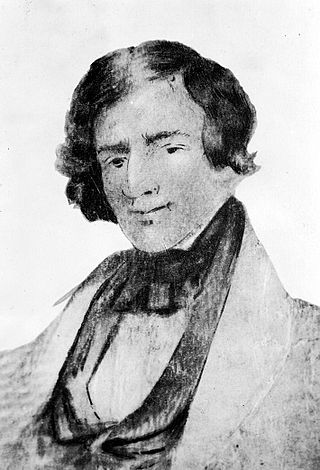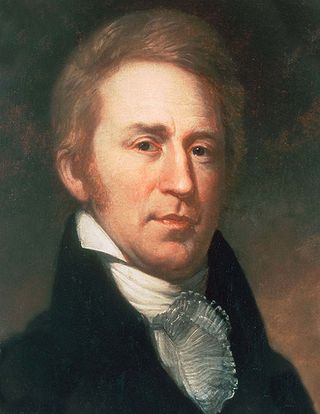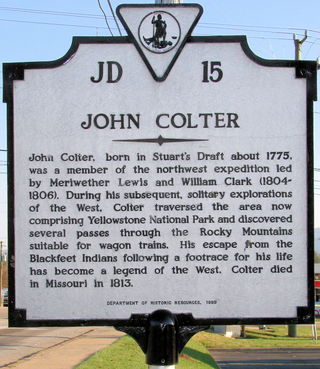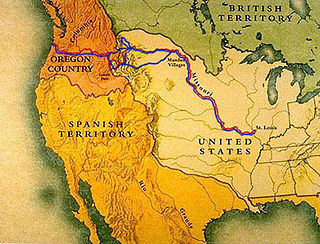Related Research Articles

The Lewis and Clark Expedition, also known as the Corps of Discovery Expedition, was the United States expedition to cross the newly acquired western portion of the country after the Louisiana Purchase. The Corps of Discovery was a select group of U.S. Army and civilian volunteers under the command of Captain Meriwether Lewis and his close friend Second Lieutenant William Clark. Clark and 30 members set out from Camp Dubois, Illinois, on May 14, 1804, met Lewis and ten other members of the group in St. Charles, Missouri, then went up the Missouri River. The expedition crossed the Continental Divide of the Americas near the Lemhi Pass, eventually coming to the Columbia River, and the Pacific Ocean in 1805. The return voyage began on March 23, 1806, at Fort Clatsop, Oregon, and ended on September 23 of the same year.

Jedediah Strong Smith was an American clerk, transcontinental pioneer, frontiersman, hunter, trapper, author, cartographer, mountain man and explorer of the Rocky Mountains, the Western United States, and the Southwest during the early 19th century. After 75 years of obscurity following his death, Smith was rediscovered as the American whose explorations led to the use of the 20-mile (32 km)-wide South Pass as the dominant route across the Continental Divide for pioneers on the Oregon Trail.

Meriwether Lewis was an American explorer, soldier, politician, and public administrator, best known for his role as the leader of the Lewis and Clark Expedition, also known as the Corps of Discovery, with William Clark. Their mission was to explore the territory of the Louisiana Purchase, establish trade with, and sovereignty over the natives near the Missouri River, and claim the Pacific Northwest and Oregon Country for the United States before European nations. They also collected scientific data, and information on indigenous nations. President Thomas Jefferson appointed him Governor of Upper Louisiana in 1806. He died of gunshot wounds in what was either a murder or suicide, in 1809.

William Clark was an American explorer, soldier, Indian agent, and territorial governor. A native of Virginia, he grew up in pre-statehood Kentucky before later settling in what became the state of Missouri.

Toussaint Charbonneau was a Canadian-born explorer, fur trapper and merchant who is best known for his role in the Lewis and Clark Expedition as the husband of Sacagawea.

The Corps of Discovery was a specially established unit of the United States Army which formed the nucleus of the Lewis and Clark Expedition that took place between May of 1804 and September of 1806. The Corps was led jointly by Captain Meriwether Lewis and Second Lieutenant William Clark. Commissioned by President Thomas Jefferson, the Corps' objectives were scientific and commercial – to study the area's plants, animal life, and geography, and to learn how the Louisiana Purchase could be exploited economically. Aside from its military composition, the Corps' additional personnel included scouts, boatmen, and civilians.

John Colter was a member of the Lewis and Clark Expedition (1804–1806). Though party to one of the more famous expeditions in history, Colter is best remembered for explorations he made during the winter of 1807–1808, when he became the first known person of European descent to enter the region which later became Yellowstone National Park and to see the Teton Mountain Range. Colter spent months alone in the wilderness and is widely considered to be the first known mountain man.

Fort Mandan was the name of the encampment which the Lewis and Clark Expedition built for wintering over in 1804–1805. The encampment was located on the Missouri River approximately twelve miles (19 km) from the site of present-day Washburn, North Dakota, which developed later. The precise location is not known for certain. It is believed now to be under the water of the river. A replica of the fort has been constructed near the original site.

George Bird Grinnell was an American anthropologist, historian, naturalist, and writer. Grinnell was born in Brooklyn, New York, and graduated from Yale University with a B.A. in 1870 and a Ph.D. in 1880. Originally specializing in zoology, he became a prominent early conservationist and student of Native American life. Grinnell has been recognized for his influence on public opinion and work on legislation to preserve the American bison. Mount Grinnell in Glacier National Park in Montana is named after Grinnell.

Patrick Gass served as sergeant in the Lewis and Clark Expedition (1804–1806). He was important to the expedition because of his service as a carpenter, and he published the first journal of the expedition in 1807, seven years before the first publication based on Lewis and Clark's journals.

The Great Falls of the Missouri River are a series of waterfalls on the upper Missouri River in north-central Montana in the United States. From upstream to downstream, the five falls along a 10-mile (16 km) segment of the river are:

Sacagawea was a Lemhi Shoshone woman who, in her teens, helped the Lewis and Clark Expedition in achieving their chartered mission objectives by exploring the Louisiana Territory. Sacagawea traveled with the expedition thousands of miles from North Dakota to the Pacific Ocean, helping to establish cultural contacts with Native American people and contributing to the expedition's knowledge of natural history in different regions.

Sheheke, Sheheke-shote, translated as White Coyote, and also known as Coyote or Big White (1766–1812), was a Mandan chief.
Events from the year 1806 in the United States.
Lewis & Clark: The Journey of the Corps of Discovery is a 1997 television documentary miniseries about the Lewis and Clark Expedition directed and co-produced by Ken Burns. It is produced by Burns' Florentine Films for Washington, DC PBS station WETA-TV, first aired on PBS on November 4 and 5, 1997.
Thomas Jefferson believed Native American peoples to be a noble race who were "in body and mind equal to the whiteman" and were endowed with an innate moral sense and a marked capacity for reason. Nevertheless, he believed that Native Americans were culturally and technologically inferior. Like many contemporaries, he believed that Indian lands should be taken over by white people.
Astoria: Or, Enterprise Beyond the Rocky Mountains is a book published in 1836 by Washington Irving.

This is a bibliography of literature dealing with the Lewis and Clark Expedition.

The following works deal with the cultural, political, economic, military, biographical and geologic history of pre-territorial South Dakota, the southern part of Dakota Territory and the State of South Dakota.

Donald Dean Jackson was an American journalist, historian, and professor of American history involving early America and the Civil War mostly. He was the founding editor of the University of Virginia's George Washington Papers project. Apart from his editing and publishing of those papers, Jackson was also noted for his consulting and editorship in the Lewis and Clark project, gathering and compiling related manuscripts into one comprehensive study. Jackson was also considered an expert historian of the American West and its exploration and authored many books and journals in that area of study.
References
- ↑ "James P. Ronda". C-SPAN.org. Retrieved January 11, 2018.
- 1 2 Ronda, James (2002). Lewis and Clark among the Indians. Lincoln: University of Nebraska Press. ISBN 978-0-8032-8990-1.
- 1 2 "Ronda, James P." Read North Dakota. Retrieved January 11, 2018.
- ↑ "James P. Ronda". NNDB. Retrieved January 11, 2018.
- ↑ Dr. James P. Ronda Accepts Invitation to Address Annual Banquet Gathering. (1981). We Proceeded On, 7(2). Retrieved from http://www.lewisandclark.org/wpo/pdf/vol7no2.pdf
- ↑ Ronda, James, P. (2002). Lewis and Clark: Among the Indians, Bicentennial Ed. Lincoln, Ne. University of Nebraska Press.
- ↑ Jenkinson, Clay (December 1, 1969). "Conversations with the great humanist James Ronda". Bismarck Tribune. Retrieved January 11, 2018.
- ↑ Ronda, James (1990). Astoria & empire (in Portuguese). Lincoln: University of Nebraska Press. ISBN 978-0-8032-8942-0.